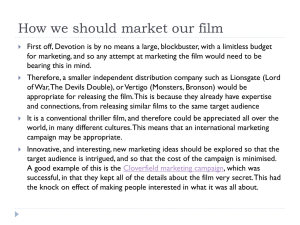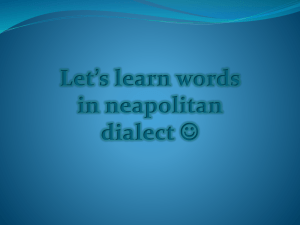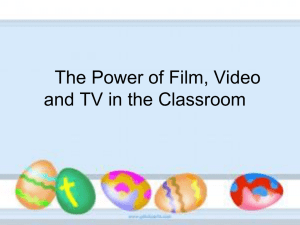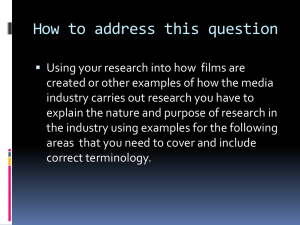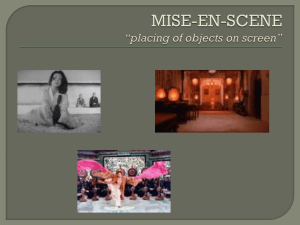Seeger – Presentation (animated)
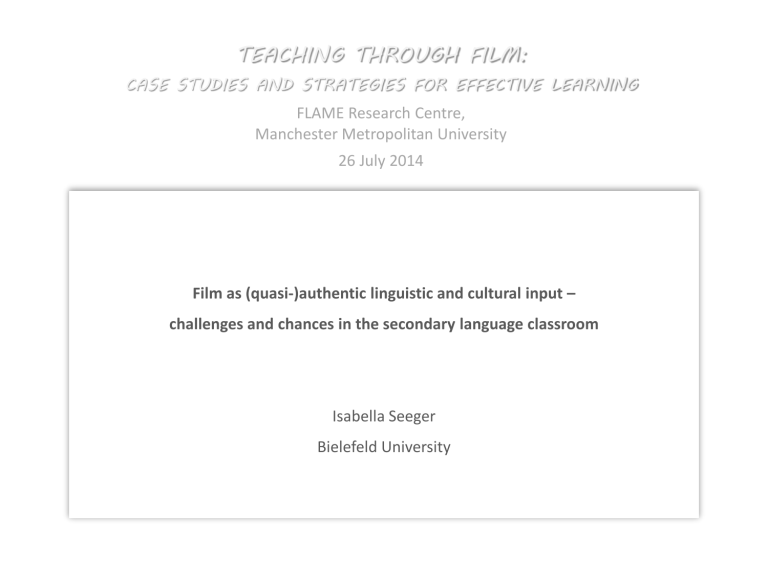
TEACHING THROUGH FILM:
CASE STUDIES AND STRATEGIES FOR EFFECTIVE LEARNING
FLAME Research Centre,
Manchester Metropolitan University
26 July 2014
Film as (quasi-)authentic linguistic and cultural input – challenges and chances in the secondary language classroom
Isabella Seeger
Bielefeld University
CONTENTS
1 Film as (quasi-)authentic input in the EFL classroom
2 Curricular input for lower secondary education
3 A holistic approach to teaching with film
References
1.1 Towards a definition of
"classroom authenticity"
1.2 Some merits of using film in the EFL classroom
3.1 Focus
3.2 Classroom methodology
3.3 Teacher's responsibilities
3.4 Assessment i Seeger 2014
1 FILM AS (QUASI-)AUTHENTIC INPUT IN THE EFL CLASSROOM 1.1 Towards a definition of
"classroom authenticity"
Film - produced for the information or entertainment of an English-speaking audience
Authentic materials
- Produced by and for native speakers
- Not produced for language teaching
- Characteristics of real-life discourse
(Nunan, 1989; Nuttall, 2005; Gilmore, 2007)
Nonfictional content
Fictional content
Limited view of authentic language
& culture
Authentic input
Representation of language & culture
Quasi-authentic input
"CLASSROOM AUTHENTICITY"
Learning situation
- Use of materials in meaningful context
- Authentic use of language
- Meaningful outcome
(Breen, 1985; Taylor, 1994; Mishan, 2005)
•
• C-R and discovery learning
• Genuinely communicative activities
Autonomous learning
Authentic output i Seeger 2014
1 FILM AS (QUASI-)AUTHENTIC INPUT IN LANGUAGE LEARNING 1.2 Some merits of using film in the EFL classroom
Film can widely supplement the input from coursebooks or teachers
"Films are such valuable and rich resources for teaching for they present colloquial
English in real-life contexts rather than artificial situations; an opportunity of being exposed to different native speaker voices, slang, reduced speeches, stress, accents, and dialects."
(King, 2002: 2)
Motivation, engagement with L2
(Sommer, 2001; King, 2002;
MacGregor, 2007)
Meaningful, contextrelated situations
(Lonergan, 1984; King, 2002)
Natural, real-life discourse
(Katchen,2002;
Gilmore,2007)
FILM
Correlation of speaking and listening skills
(Kusumarasdyati, 2004;
Istanto, 2009)
Visual support
(Kusumarasdyati, 2004)
Language variation
(Sherman, 2003;
King, 2002) i Seeger 2014
2 CURRICULAR INPUT FOR LOWER SECONDARY EDUCATION
•
Common European Framework of Reference for Languages
(CEFR)
The German EFL curriculum endorses CEFR goals and suggestions regarding communicativeness and meaningfulness
Suggested possible input:
Different texts from all kinds of media, including TV & cinema films
Council of Europe (2001: 94)
•
EFL curriculum for lower secondary education
Prescribed input:
Scripted materials
(coursebook & audio/video materials, graded readers)
MSW (2014)
• Standardised assessment
• Non-native speaker teachers
Inauthentic content and language
(Sheldon, 1988;
Mauranen, 2004;
Römer, 2004, 2006,
2007; Rühlemann, 2008)
Unfamiliar with language variation
(Conrad, 2004)
Frequent output:
"Abiturspeak"
(Mukherjee, 2004: 247) i Seeger 2014
Desired output:
Appropriate in context
3 A HOLISTIC APPROACH TO TEACHING WITH FILM
3.1 Focus
Focusing on content and culture rather than on language
Primary focus: non-linguistic features
• Supplement or contrast to coursebook information
• Diverts attention from L2
• Meaningful language production
"...the best input is so interesting and relevant that the acquirer may even
‘forget’ that the message is encoded in a foreign language."
(Krashen, 2009: 66)
Secondary focus: language
• Language variation
• Action-related registers
(Gibbons, 2001)
• Discovery of social & discourse functions
• Unconscious acquisition of chunks
(Nunan, 1999; Krashen, 2009) i Seeger 2014
!
Crucial: lowered expectations
Learners:
• Comprehension of language & content
Teacher:
• Language comprehension vs language production
• Learners' ability to simplify
• Learners' enthusiasm about film
3 A HOLISTIC APPROACH TO TEACHING WITH FILM
Raising interest, reducing anxiety, facilitating comprehension
3.2 Classroom methodology
Encouraging autonomous learning and language production
Pre-viewing
• Introducing the topic
(film trailer, summary/speculation, protagonists)
• Relieving language difficulty
(key vocabulary; optional: subtitles)
• Creating a cinematic atmosphere
Younger or low-ability learners:
• Short films or extracts
• Simple guided discovery tasks
• Guided presentation
While-/after-viewing
• Drawing attention to culture & language
• Research on background info
• Focus on chosen aspects
Teenage or intermediate learners:
• Full-length films or extracts; book extracts & film adaptations
• Semi-autonomous research projects
• Semi-autonomous presentation i Seeger 2014
For activities, see Stempleski & Tomalin, 2001;
Sherman, 2003, Thaler, 2014, etc.
3 A HOLISTIC APPROACH TO TEACHING WITH FILM
Learners' enjoyment = teacher's frustration?
No...
...grammatical accuracy & rule adherence
...learning of isolated words
...learning of correct spelling
...language production moulded on template phrases
3.3 Teacher's responsibilites
Teachers' shifting responsibilities
Challenges:
• Specific design/adaptation of teaching materials
• Acceptance of "untidy" language (input & output)
• Difficulty of measuring unconscious language acquisition
Rewards:
• Relief of responsibility as language expert & role model
• Relaxation of constant classroom control
• Personal enrichment & motivation i Seeger 2014
3 A HOLISTIC APPROACH TO TEACHING WITH FILM
Assessing learners' engagement with content, culture and language
3.4 Assessment
Case study:
• Coursebook units & film units
• Comparative long-term assessment
• Film enhanced retention of content, cultural aspects & vocabulary
(Seeger, 2011)
"...it can often be the case that these messy, layered and overlapping types of learning are not enhanced in the orderly progression of
'covering the material' in the test-based classroom."
(Costigan, 2008: 159)
Possible foci in assessment :
Short- & long-term:
• Comprehension of content
• Cultural knowledge
• Appropriate use of vocabulary in context
• Written/oral language production
• Ability to deal with related authentic materials
Long-term:
• Ability to relate knowledge from the film to real-world situations
• Fluency and appropriateness in language use i Seeger 2014
REFERENCES
Breen, M.P. (1985) 'Authenticity in the language classroom.' Applied Linguistics 6/1: 60-70
Conrad, S. (2004) 'Corpus linguistics, language variation, and language teaching.' In Sinclair, J. (ed.) How to Use Corpora in
Language Teaching. Amsterdam: Benjamins: 67-85
Costigan, A.T. (2008) Teaching Authentic Language Arts in a Test-Driven Era. Abingdon/New York: Routledge
Council of Europe (ed.) (2001) Common European Framework of Reference for Languages: learning, teaching, assessment.
Cambridge: Cambridge University Press
Gibbons, P. (2001) 'Learning a New Register in a Second Language.' In Candlin, C. N. and Mercer, N. (eds.) English Language
Teaching in its Social Context. Abingdon/New York: Routledge: 258-270
Gilmore, A. (2007) 'Authentic materials and authenticity in foreign language learning.' Language Teacher 40: 97-118
Istanto, J.W. (2009) 'The Use of Film as an Innovative Way to Enhance Language Learning and Cultural Understanding.' Electronic
Journal of Foreign Language Teaching 6, Suppl. 1: 278-290
Katchen, J.E. (2002) 'Video in ELT – Theoretical and Practical Foundations. Proceedings of the 2002 KATE International
Conference.' The Korea Association of Teachers of English: 256-259
King, J. (2002) 'Using DVD feature films in the classroom.' ELT Newsletter, Article 88/Feb 2002
Krashen, S. (2009) Principles and Practice in Second Language Acquisition. (1st Internet ed.) Available at http://www.sdkrashen.com/content/books/principles_and_practice.pdf (Accessed 13 July 2014)
Kusumarasdyati (2004) 'Listening, Viewing and Imagination: Movies in EFL Classes.' 2nd International Conference on Imagination
and Education, Vancouver, Canada, July 14-17, 2004. Clayton: Monash University
Lonergan, J. (1984) Video in Language Teaching. Cambridge: Cambridge University Press i Seeger 2014
REFERENCES
MacGregor, L. (2007) 'Looking at cultural differences in movie trailers.' In Bradford-Watts, K. (ed.) JALT 2006 Conference
Proceedings. Tokyo: JALT
Mauranen, A. (2004) 'Spoken corpus for an ordinary learner.' In Sinclair, J. (ed.) How to Use Corpora in Language Teaching.
Amsterdam: Benjamins: 89-105
Mishan, F. (2005) Designing Authenticity into Language Learning Materials. Bristol: Intellect Books
MSW (Ministerium für Schule und Weiterbildung des Landes Nordrhein-Westfalen) (ed.) (2014) Zulasung von Lernmitteln in NRW
[Approved teaching materials for NRW; my translation]. Available at http://www.schulministerium.nrw.de/docs/Schulsystem/Medien /Lernmittel/index.html (Accessed 14 July 2014)
Mukherjee, J. (2004) 'Bridging the Gap between Applied Corpus Linguistics and the Reality of English Language Teaching in
Germany.' In Connor, U. and Upton, T.A. (eds.) Applied Corpus Linguistics. A Multi-dimensional Perspective. Amsterdam:
Rodopi: 239-250
Nunan, D. (1989) Designing Tasks for the Communicative Classroom. Cambridge: Cambridge University Press
Nunan, D. (1999) Second Language Teaching and Learning. Boston: Heinle & Heinle
Römer, U. (2004) 'A corpus-driven approach to modal auxiliaries and their didactics.' In Sinclair, J. (ed.) How to Use Corpora in
Language Teaching. Amsterdam: Benjamins: 89-105
Römer, U. (2006) 'Pedagogical Applications of Corpora: Some Reflections on the Current Scope and a Wish List for Future
Developments.' Zeitschrift für Anglistik und Amerikanistik 54/2: 121-134
Römer, U. (2007) 'Learner Language and the Norms in Native Corpora and EFL Teaching Materials: A Case Study of English
Conditionals.' In Volk-Birke, S. and Lippert, J. (eds.) Anglistentag 2006 Halle. Proceedings. Trier: Wissenschaftlicher Verlag Trier:
355-363 i Seeger 2014
REFERENCES
Rühlemann, C. (2008) 'A Register Approach to Teaching Conversation: Farewell to Standard English?' Applied Linguistics 29/4: 672-
693
Seeger, I. (2011) Exploring film as EFL coursebook supplements and motivational stimulus: A German secondary school case study.
Master's dissertation. Birmingham: University of Birmingham. Available at http://www.birmingham.ac.uk/Documents/collegeartslaw/cels/essays/matefltesldissertations/ExploringfilmascoursebooksupplementsISeeger.pdf (Accessed 18 July 2014)
Sheldon, L.E. (1988) 'Evaluating ELT textbooks and materials.' ELT Journal 42/4: 237-246
Sherman, J. (2003) Using Authentic Video in the Language Classroom. Cambridge/New York: Cambridge University Press
Sommer, P. (2001) 'Using film in the English classroom: Why and how.' Journal of Adolescent & Adult Literacy 44/5: 485-487
Stempleski, S. and Tomalin, B. (2001) Film. Oxford: Oxford University Press
Taylor, D. (1994) 'Inauthentic Authenticity or Authentic Inauthenticity?' TESL-EJ 1/2: 1-12
Thaler, E. (2014) Teaching English with Films. Paderborn: Schöningh i Seeger 2014
IMAGES THANKS TO
Film:
Cantet, Laurent (2008) Entre les murs [The Class]. France: Haut et court et al.
Chadha, Ghurinder (2002) Bend it like Beckham. UK: Kintop Pictures et al.
Daldry, Stephen (2000) Billy Elliot. UK: BBC Films et al.
Egoyan, Atom (1999) Felicia's Journey. UK: Alliance Atlantis Communications et al.
Hill, Tom (2006) Garfield: A Tail of Two Kitties (aka Garfield 2). USA: Twentieth Century Fox et al.
Jennings, G. (2007) Son of Rambow. UK: Hammer & Tongs et al.
Kaye, Tony (1998) American History X. USA: New Line Cinema et al.
Van Sant, Gus (2007) Paranoid Park. USA: MK2 Productions et al.
Other:
Autonomous students: http://tesolatrennertnyc.files.wordpress.com/2011/12/students20talking20in20class.jpeg
Coathangers (1): http://cdn3.micasa.ch/medias/sys_master/large/d/f/4/3/id_9115088355358_large.jpg
Coathangers (2): http://www.dannielledishes.com/dannielle-dishes-1/?offset=1301670996000
Media signpost: http://bookpublicityservices.com/wp-content/uploads/2013/04/Media.jpg
Speaking-Listening: http://jackson-consulting.com/wp-content/uploads/2013/12/listening.jpg
They'll figure it out: http://transitionculture.org/wp-content/uploads/2013/05/LaurelAndHardy-TheyThinkOfSomething.jpg
i Seeger 2014
i Seeger 2014

